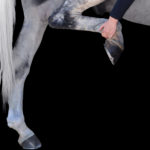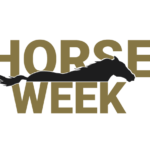Gladstone, N.J., October 15, 2009 — I’m a big believer in ecumenical equestrianism. What do I mean by that little bit of alliteration? Simply that we’re all horse people. While we tend to spend most of our time in our own groups, whether they involve show jumping, reining or whatever, cross-over reminds us there’s a big picture in this game, and we have a lot in common with people–and equines–outside our specialties.
There was a good example of this at the U.S. Equestrian Team (USET) Foundation headquarters last weekend. (Things are really hopping at the USET this month what with the Talent Search finals, the Pennfield “That’s a Promise” Tour Finale, etc.; it’s nice to see the place so busy!)

This occasion was the Driving for Surviving Human Spirit Award presentation and luncheon October 11. Driving for Surviving, part of the sharingVillage Survivor Groups works with children who have survived cancer or other life-threatening diseases, and in many cases, are still undergoing treatment.
As is the case with therapeutic riding, driving enables these kids to regain or attain self-esteem after (or during) a long course of treatment, helping to empower them while facilitating exercise and forging relationships with mentors and others in their situation.
The honoree at this affair was Candi Covino Aversenti, a big-time Saddlebred owner and rider who has won ribbons everywhere from Madison Square Garden to the World Championships in Kentucky. The grandmother of five is also CEO and board chairman of General Magnaplate Corp., an international metal-finishing firm.
But she still manages to take time to help the Driving for Surviving kids learn to deal with ponies and mini-horses. Candi and her husband, Ed, get down and make one-to-one contact with those in the program.
The kids did an adorable drill with their minis, choreographed by 1991 World Pairs Driving gold medalist Sharon Chesson, who looks at home behind a mini, just the way she used to behind her big Holsteiners.

Some of Candi’s many friends in the Saddlebred industry came to support her, a great example of cross-pollination as they were exposed to what Driving for Surviving is all about. The group included author and TV star Carson Kressley (“Queer Eye for the Straight Guy”), a lifelong rider who just flew in from a new project he is working on in L.A. I met Carson in 1995 when he was working for the American Horse Shows Association, the predecessor of the U.S. Equestrian Federation. Carson had us all laughing then; I knew he’d be headed for bigger things before long.
I asked Carson why he had taken time out of his crazy busy schedule to be with Candi, and here’s what he told me.
He wasn’t the only one who made a detour to come here. The honorary chairman of the event was six-time dressage Olympian Robert Dover (there’s that ecumenical thing again.)
Robert’s extra-busy these days, having taken a job as coach/technical advisor for the Canadian dressage team. It was quite a bounce-back after Robert was passed over for a similar post with the American team. But don’t think that this was about “I’ll show you.”
“What I really hope is that everyone knows that is the opposite of how I feel,” said Robert, who has expressed his best wishes to the American team and genuine enthusiasm about working with the folks north of the border.
“I knew, just as I had felt for the U.S., I could hopefully bring a high quality of work ethic and constructive and creative process to the table,” he said. “The job has been beautifully tailored to my life, such that I feel like I can do all of the things I hoped to do with the U.S. for Canada, and I’m really looking forward to it.”
The Equestrian Aid Foundation, of which Robert is one of the founders, has been a supporter of Driving for Surviving. But Robert’s personal involvement began during the national dressage championships here in June, when he met Gary Johnson. The Driving for Surviving crew was supposed to put on a drill during the championships as an exhibition. The rain that dampened the weekend forced a cancellation, however, so the kids got to come up to the trophy room and watch. Robert chatted there with Gary, a city kid who is one of the drivers. Gary walks with crutches, but sheds them when he gets in the carriage and drives like a pro.
He and Robert had an instant affinity, so Robert has been using his contacts around the world to try to find a nifty driving pony for Gary. Earlier this year, Gary’s heart was broken when Boxcar Willie, a pony donated by world championships four-in-hand driver Jimmy Fairclough and his family, had to be put down. He had bonded with Willie, so it’s been a tough time for 17-year-old Gary. But being with Robert has provided solace for Gary and done a lot for his mentor, too.
“The minute you meet him and know his story you see he’s all smiles and thankful for what he has and having horses in his life. You have to help a person like that,” said Robert, who greeted Gary with a heartfelt hug during the awards presentation.

“You can tell that in his character is a much older soul than this young kid. He has a wisdom about him that makes him able to have that calm attitude around horses. Horses can create all sorts of miracles for people who are disabled,” said Robert.
The luncheon that followed the presentation was held in the USET Foundation’s landmark stables, with its herringbone tile floors and brass balls on the stalls. Actually, there were even tables in the stalls!
I stopped for a moment to say hello to Gary and ask him about the amazing day, with scores of people, dressed to the nines, on hand to watch him and his friends do their thing.
The ceremonies ended with Candi and Robert climbing aboard Lou Piancone’s beautiful coach for a tour of the arena behind a gleaming four-in-hand of bay gelderlanders.
After Candi disembarked, we talked about Driving for Surviving and how she got involved. It stemmed from her long friendship with Shelley Zlotkin, the force behind the founding of the group.
“I was totally on board because I had driven Hackney ponies…so I was more than anxious to be a coach,” Candi said.
She had been retired from showing when she began coaching, but doing it “instilled the spirit of riding and driving in me again. I came back to it with a whole new view of why I had been given this talent to be able to give back and share it. I think the horses work for these kids because every child would want to have a pony. There’s an immediate connection there. Anybody who’s in horses knows horses are therapeutic. It works because the children have an immediate bond with them.”

She pointed out the driving “really empowers them, because anything involving horses calls for concentration and dedication. Whether they’re little or big horses, there’s still that horse power, that feeling that as a human being you are able to contain that. It’s an invaluable experience when you take that and apply it to your everyday life. You really feel you can do things you might not have been able to do otherwise.”
She had mentioned in passing that riding her show horse, Cumberland Crescent (aka Red Dawg) had gotten her through some tough times, so I asked her to tell me about that.
Candi, a 1972 graduate of Endicott College who is also on the board there, has brought that school into the equation and a group of the Endicott equestrian team members came down from Massachusetts to help.
Why don’t you think “ecumenical equestrianism” and see if you can do some kind of cross-over, perhaps with a rescue group or therapeutic riding organization? Harness the type of energy that Driving for Surviving has used so effectively.
Be sure to check back Sunday night, October 18 for my postcard from the Dansko Fair Hill International eventing competition.
Until then,







